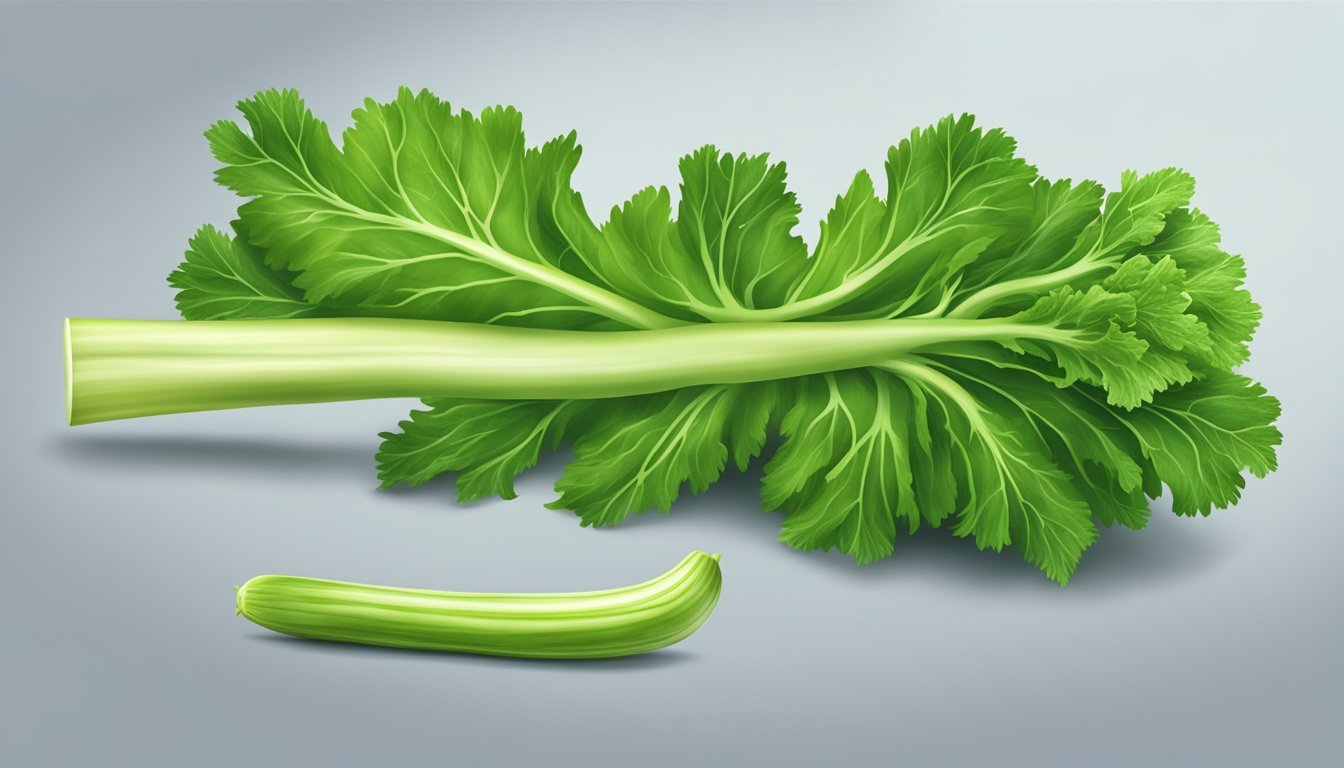Is It Safe to Eat Raw Celery?
Uncovering the Facts
Eating raw celery is considered safe and is a common practice around the world. Celery, a crunchy vegetable with a high water content, is often incorporated into diets as a low-calorie snack that can aid in hydration. Its fibrous nature also contributes to the diet's overall fiber intake, which is important for digestive health. While there is a general consensus on the safety of consuming raw celery, individuals with digestive sensitivities may experience discomfort, such as gas or bloating, if excessive amounts are consumed.
Like many vegetables, consuming celery raw helps retain its full array of nutrients. The cooking process can potentially reduce certain vitamins and antioxidants. However, it's worth noting that the difference in nutrient content between raw and cooked celery is not significantly impactful on health. Celery's nutrient profile includes vitamins such as vitamin K and vitamin C, as well as phytochemicals that can contribute to overall health. Additionally, the ease of including raw celery in meals makes it a versatile component in a balanced diet, whether it's added to salads, smoothies, or consumed on its own as a snack.
Overview of Celery
Celery is a widely consumed vegetable, belonging to the Apiaceae family. It is recognized for its distinctive crunch and high water content, which make it a refreshing snack, both raw and in cooked forms.
Nutritional Profile: Celery contains a rich composition of vitamins and minerals, including:
Vitamin A: Supports vision and immune function.
Vitamin K: Essential for blood clotting.
Folate: Crucial for DNA synthesis and repair.
Potassium: Aids in muscle contractions and heart function.
Additionally, celery provides an ample amount of dietary fiber, vital for digestive health. Its low glycemic index also ensures minimal impact on blood sugar levels.
Health Benefits: The health benefits of celery are attributed to its impressive nutrition profile. It supplies valuable antioxidants, such as flavonoids and vitamin C, which help combat cellular damage and inflammation.
Consumption: Celery can be enjoyed in its raw state, where its full crunchiness is preserved, accentuating the texture of salads and serving as a carrier for dips. When cooked, it integrates well into soups and stews, lending a subtle flavor.
Celery Leaves: The leaves of celery are often overlooked but are equally nutritious. They can be used in much the same way as other leafy greens and enhance the flavor profile of various dishes.
In conclusion, celery's versatility and nutrient density make it a beneficial addition to a balanced diet. Whether eaten raw or cooked, celery provides significant health advantages without compromising on flavor or texture.
Nutritional Profile of Raw Celery
Raw celery is recognized for its low calorie content and rich array of nutrients, from essential vitamins and minerals to a host of beneficial phytonutrients.
Vitamins and Minerals
Celery is an excellent source of vitamin K, providing about 25–30% of the daily recommended intake in a single serving. It also contains vitamin A and C, although in smaller quantities. Essential minerals present in celery include potassium, which is important for cardiovascular health, and folate, which is crucial for DNA synthesis and repair. Other minerals such as calcium, magnesium, and iron are also found in this crunchy vegetable, enhancing its nutritional value.
Caloric Value and Macronutrients
One cup of chopped celery (around 101 grams) contains approximately 16 calories. This low caloric count is associated with its high water content. Macronutrient-wise, celery offers:
Carbohydrates: around 3 grams per cup, with more than half of this amount coming from dietary fiber
Protein: negligible amounts
Fat: virtually zero
Sugar: 1.4 grams per cup in the form of natural sugars
Phytonutrients and Antioxidant Properties
Celery contains phytonutrients such as flavonoids, which have antioxidant properties. Notably, apigenin and luteolin are two flavonoids found in celery that contribute to its health benefits. These plant compounds are known for their anti-inflammatory effects and the ability to combat oxidative stress. The presence of antioxidants in celery reinforces its role in a healthy diet, corroborating its potential to support the body’s defense against various health issues.
Health Benefits of Eating Raw Celery
Raw celery provides significant health benefits due to its nutritional content and can have a positive impact on one’s diet. This section focuses on how incorporating raw celery into one’s diet could benefit cardiovascular health, reduce inflammation, aid in cancer prevention, and assist in weight management.
Cardiovascular Health
Celery contains important vitamins and minerals that support heart health, including potassium which helps manage blood pressure levels. Consuming celery may aid in maintaining a lower risk of heart disease due to its low glycemic index and the ability to help lower cholesterol levels.
Anti-inflammatory Effects
Rich in phytonutrients, celery exhibits anti-inflammatory properties that may relieve symptoms of conditions like arthritis and gout. Regular consumption of celery can help reduce swelling and pain associated with these ailments.
Cancer Prevention
Celery's antioxidants play a role in combating free radicals that could lead to cancer. As part of a diet high in fruits and vegetables, the addition of raw celery might contribute to the prevention of certain cancers.
Weight Management
As a low-calorie snack packed with dietary fiber, celery can promote weight loss and provide a feeling of fullness. The fiber content not only aids in digestion but also helps maintain a healthy weight by reducing overeating.
Culinary Uses of Raw Celery
Raw celery plays a versatile role in the culinary world, lending its crisp texture and mild, refreshing taste to a variety of dishes. It is not only a foundational ingredient in many salads but also a staple for healthy snacks and hydration-centric recipes.
Celery in Salads
Celery's crispness provides a satisfying contrast in leafy salads, and it pairs well with a multitude of dressings. A classic chicken salad often features diced celery for crunch, paired with a creamy mayonnaise base. In more contemporary recipes, one might sprinkle chopped celery leaves atop salads for an herbaceous note.
Healthy Snacks with Celery
Celery sticks are a favorite for health-conscious snackers. Peanut butter and raisins, known together as 'ants on a log', is a nostalgic snack where the celery's groove acts as a vessel. Alternatively, celery can be dipped in hummus or topped with cheese, serving as a low-calorie, nutrient-rich snack option.
Hydration-Focused Recipes
Given its high water content, celery is ideal for hydration. Freshly blended celery integrates well into smoothies, contributing to fluid intake while providing essential nutrients. Juices often include celery as a base for its hydrating properties and subtle flavor that doesn't overpower other ingredients.
Other Celery-Infused Dishes
Celery is not limited to raw applications; it is also foundational in cooked preparations like soups and mirepoix—a culinary trinity of onions, carrots, and celery that builds the base flavor for numerous dishes. However, when used raw, celery's flavor adds a crunchy, fresh element that can be both complementary and central to recipes like Asian-style salads or Mediterranean food influences.
Safety and Precautions
When consuming raw celery, individuals should be mindful of potential pesticide exposure, digestive issues, and allergic reactions to ensure a safe eating experience.
Pesticides and Organic Options
Celery is often exposed to pesticides during cultivation. According to the Environmental Working Group, it frequently appears on their list of produce with the highest pesticide residues. This can raise concerns regarding long-term health and safety. Organic celery is an alternative that typically contains lower levels of pesticides. Washing celery thoroughly or peeling it can also help reduce pesticide residue.
Key tips:
Choose organic celery to minimize pesticide exposure.
Wash celery stalks thoroughly, or peel them when possible.
Digestive Considerations
Raw celery is high in fiber, which can aid digestion and help maintain healthy cholesterol levels. However, some individuals might experience gas or bloating after consuming it due to its high fiber content. Eating celery in moderate amounts is usually recommended to avoid digestive discomfort.
To ease digestion:
Consume celery in moderation if prone to digestive issues.
Chew celery stalks well to help with fiber breakdown.
Allergies and Sensitivities
Though not common, some people may have an allergy to celery, which can cause reactions such as itchiness and discomfort. Those sensitive to psoralens, natural compounds found in celery, should also take care. While cooking can degrade these compounds, raw celery retains them and therefore might increase sensitivity to ultraviolet radiation.
If experiencing allergies:
Pay attention to any allergic reactions, such as skin itchiness or discomfort.
Consider eating cooked celery to reduce potential sensitivity to psoralens.
Comparative Analysis
When comparing the consumption of raw versus cooked celery and examining celery in relation to other similar vegetables, it is important to consider the alterations in nutritional content and the potential benefits from plant compounds present in these vegetables.
Raw vs. Cooked Celery
Raw celery is a popular crunchy, low-calorie snack often praised for its nutritional content. It retains a high water content which makes it hydrating, and it is a source of dietary fiber, vitamin K, vitamin C, and potassium. Cooking celery, on the other hand, can reduce certain nutrients such as vitamin C, which is sensitive to heat, but it can increase the availability of other nutrients and make them easier to digest. Certain plant compounds in celery, such as antioxidants, may also become more concentrated when the water content is reduced through cooking.
Nutrition Content (per 100g):
Raw Celery:
Dietary Fiber: 1.6g
Vitamin C: 3.1mg
Vitamin K: 29.3μg
Cooked Celery:
Dietary Fiber: 1.2g
Vitamin C: 2.7mg
Vitamin K: 19μg
Celery and Related Vegetables
Celery is part of the Apiaceae family, which includes other vegetables such as carrots, parsley, and parsnips. These vegetables share similarities in terms of plant compounds and nutrient profiles, but each has its unique characteristics. For instance, carrots are richer in beta-carotene, while parsley is very high in vitamin K. Celery root, also known as celeriac, is related to celery and is a good source of minerals and fiber as well. These vegetables all contain various levels of antioxidants and anti-inflammatory compounds that can contribute to overall health.
Nutrient Comparison:
Celery: High in vitamin K, vitamin C, potassium.
Carrots: High in beta-carotene, fiber.
Parsley: Extremely high in vitamin K, good source of vitamin C.
Parsnips: Good source of fiber, vitamin C, and folate.
Celeriac (Celery root): High in fiber, good source of vitamins B6 and C.
Supplementary Topics
In this section, we examine the use of celery in alternative medicine, its nutritional implications during pregnancy, and its role in various diets.
Celery in Alternative Medicine
Celery, particularly celery seed extract, is employed in alternative medicine due to its anti-inflammatory properties. Practitioners may recommend celery or celery supplements for conditions believed to be related to inflammation, such as arthritis or gout. Celery seed extract is also associated with potential benefits for managing fever, though reliable scientific data supporting these uses are limited.
Nutrition During Pregnancy
Celery offers vital nutrients that are important during pregnancy, such as vitamin A and folate. Adequate folate intake is critical as it helps prevent neural tube defects. However, pregnant women should consume celery in moderation and ensure it is thoroughly washed to avoid potential contaminants.
Vitamin A is crucial for the mother's cellular health and the baby's development.
Folate supports the healthy development of the fetal nervous system.
Role in Specific Diets
Celery is often included in diets focusing on heart disease, type 2 diabetes, and weight management due to its low calorie content and beneficial nutrients. The Academy of Nutrition and Dietetics acknowledges celery as a healthy vegetable choice for most diets.
In low-calorie diets, celery provides satiety without excess caloric intake.
For managing cholesterol and type 2 diabetes, the fiber in celery may help stabilize blood sugar and lipid levels.
Due to its low sodium content, celery is also suitable for diets aiming to reduce the risk of heart disease.







